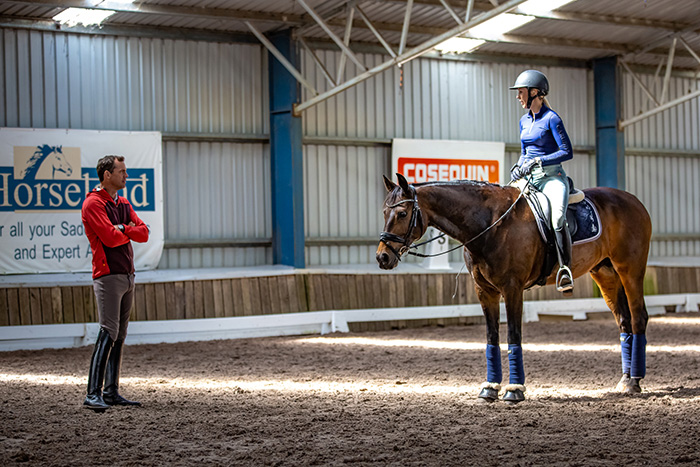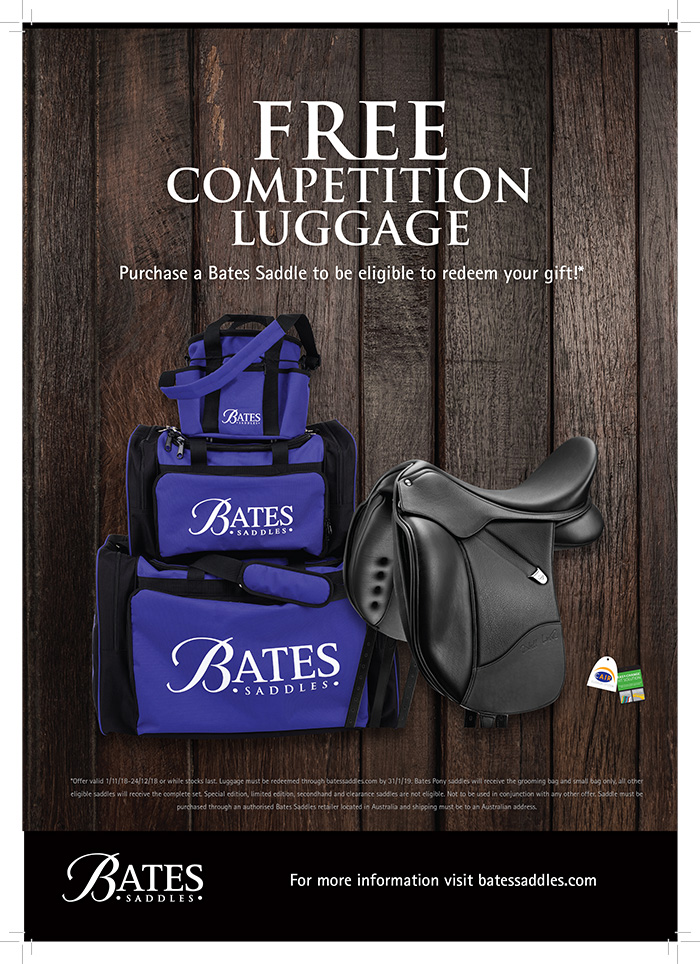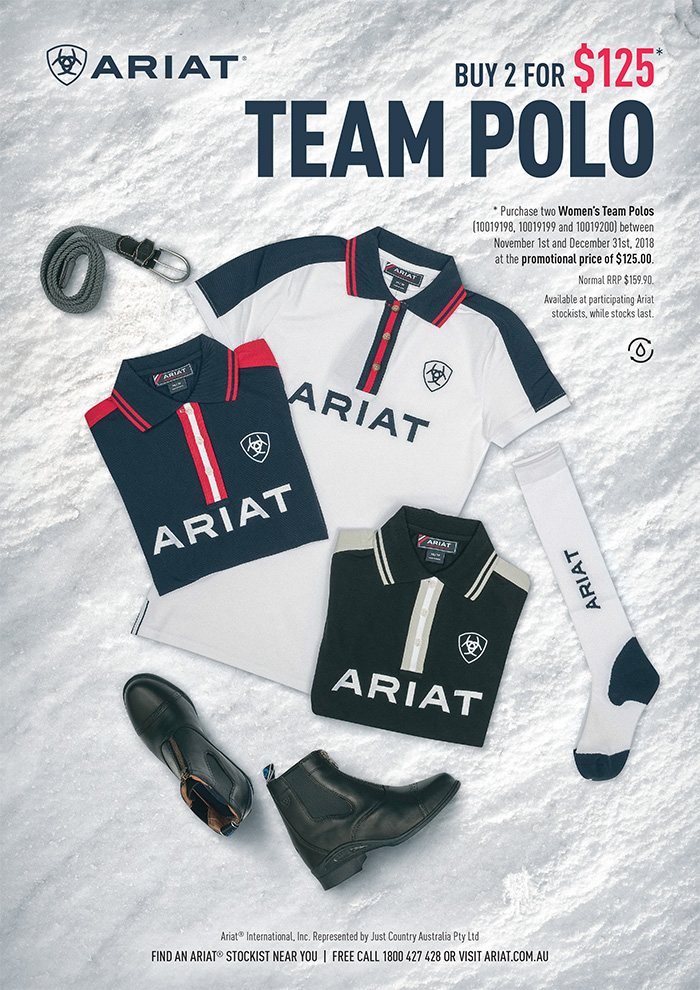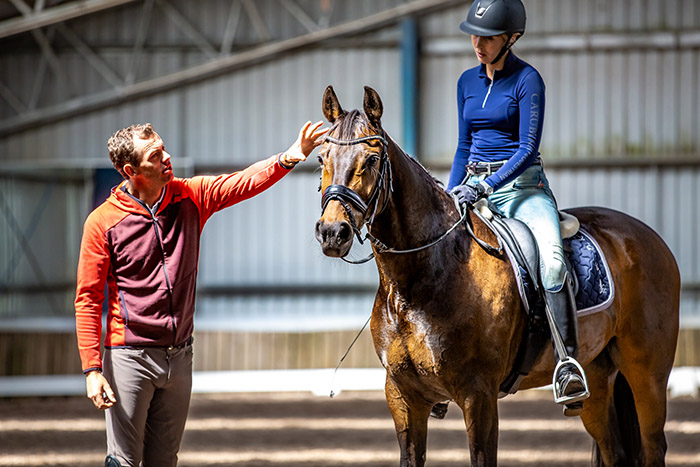
By Ute Raabe
Photos Sharlene Phillips – One Eyed Frog Photography https://www.facebook.com/OneeyedfrogPhotography/
Stefan Wolff may not have the public profile of a Carl Hester or an Ingrid Klimke, but those in the know appreciate the (very) tall German as an excellent instructor and rider. A quick Google search produces many glowing reports on his clinics and some very impressive credentials. Stefan completed his ‘Bereiter’ education with none other than the legendary Klaus Balkenhol. He also spent many years as acting director and second-in-command to Martin Plewa in the Westphalian Riding School, before moving to California to coach and compete for several years. These days he’s back in Germany, running a competition stable near Münster, but his clientele is truly international — Germans, Spaniards, Aussies, Japanese and Americans work for him, and with him, as owners, students or trainees.
For the past twelve years Stefan has made a regular trip Down Under, giving dressage clinics in Sydney, where he has created a loyal following in the local equestrian community. So when I heard the news that he was finally coming to Victoria for the first time, I did not hesitate to book a spot. Getting a lesson with a German instructor — in German — would feel a bit like a homecoming after all!
Yet the closer the date of the clinic came, the more the self-doubt crept into my mind. Would it be worth it? Were we even up to Stefan’s standard? What if we embarrassed ourselves in front of the other riders? What was I going to write about in this article?
Perhaps you should know a little bit about me first. I am German, but have been calling Australia home for almost 14 years. Although I grew up with horses, and come from a family of devoted equestrians, I did not enjoy the classic “little girl gets a pony” upbringing. So I am somewhat of a late starter when it comes to training and competing a young horse. Alliance, aka Dino, is my cheeky eight-year-old Warmblood, by imported stallion Smash Hit. We are training at elementary level and this is our first proper clinic.
Day 1 – Tight & Tense
Monday morning, the adventure begins. Dino and I have a long drive ahead of us, 186 km from Birregurra to Officer, or the things you do when you have hopes of becoming a better rider. The traffic gods are kind to us, we enjoy an easy run and arrive at Jesmond Dene Stud in good spirits.
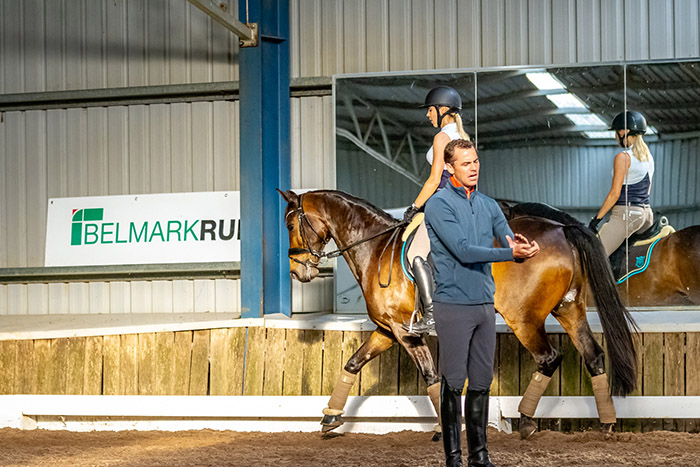
I watch a couple of the earlier lessons and like Stefan’s cool, calm approach. Everyone who leaves the arena is sweating, but also smiling, and I take that as a positive sign. At the end of the day it’s our turn, Stefan’s final lesson. I bring Dino into the indoor arena early, worried that he is going to shy at everything from the mirrors, to the green ferns, to the chairs for the fence-sitters. Alas, Mr Cool just snorts a little at the sandbags and the white arena fencing and then proceeds to admire his reflection in the mirror. Yeah, right!
Before the lesson I had great expectations of practising our lateral movements, and maybe working on some flying changes. After all, that was what we had been working on at home. Contact issues, straightness and suppleness were a thing of the past, were they not? But once we start trotting, it becomes apparent that today is not going to be smooth sailing.
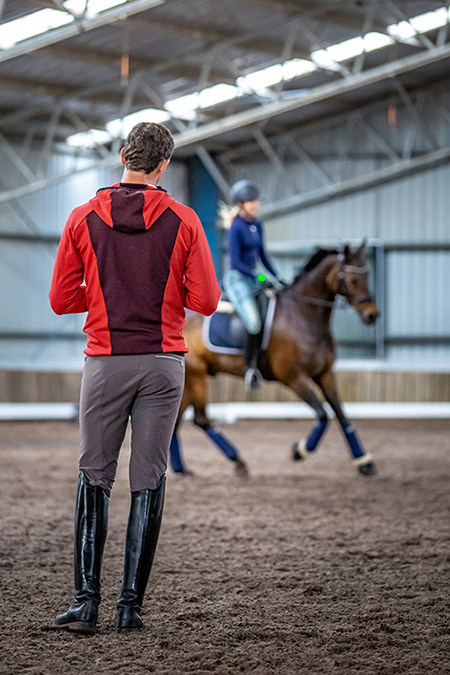 more follows
more follows
Dino is grinding on the bit, opening his mouth and not trusting my hand. Maintaining a solid contact was one of our past struggles, but something that we had successfully overcome. I know I have to ride forward and maintain the contact with my seat and legs before I apply too much rein aid and risk that my hands become too strong and rigid. So I aim for a soft hand and try to ride Dino into the bit, but the contact issues continue.
Stefan watches me quietly for a little while and then shares his observations. Our outline and frame may look acceptable in the mirror but there’s a definite lack of suppleness. Stefan shows me where the problem stems from. Dino is tight in the back and resisting in his neck, so his back works on one level, his head and neck on another. Consequently the movement is not flowing through his body and his back is not swinging.
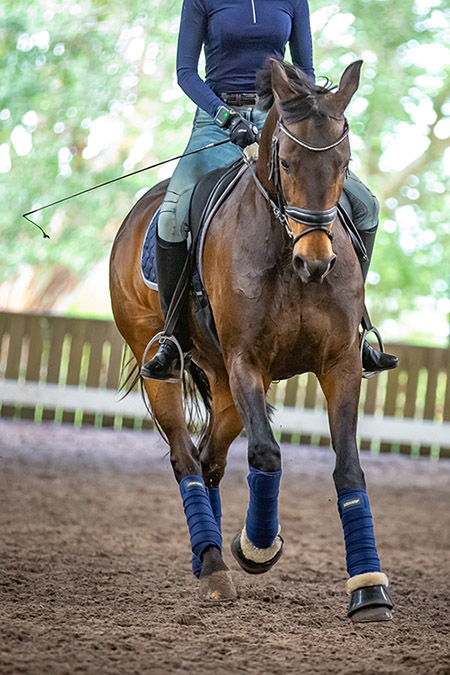
Dino needs to relax over his back and wither, lengthen his neck and seek the bit. Stefan asks me to ride him a little lower and longer. He explains that while I should never force the contact with my hands, I can’t be too defensive and shy with my rein either. I need to provide a steady grip on the rein and allow my horse to approach the bit with confidence. Too little connection with my hand means that he will just come behind the bit.
Horses develop a good and consistent contact out of contented carriage and suppleness. A good contact in return provides them with the security to regain their balance in all three paces and will lead to rhythm and relaxation.
So for the next 40 minutes that is exactly what we do. Stefan has us working on trot and canter circles, just trying to relax my tense horse and improve the connection. I feel a little deflated, but even the best German instructor can’t wave a magic wand and turn you and your horse into Charlotte and Valegro. Expectations are one thing, horses are another, and sometimes you just have to work with what you got and do the best you can.
Day 2 – The Equine Brachiocephalicus Muscle
The what? Today’s lesson turns into a bit of an anatomy class, but more in a moment. We start our lesson off on a better note than yesterday, a night’s rest has done the trick for both of us.
In an earlier lesson Stefan asked the rider to ride multiple loops along the long side, almost like a slalom. The horse showed some signs of tightness in the back at the beginning of the lesson and this exercise visibly made its back and back muscles more supple. I mention this to Stefan and while he agrees that it will also be a great tool for Dino, he adds that first we need to be more solid in the contact, self-carriage and balance.
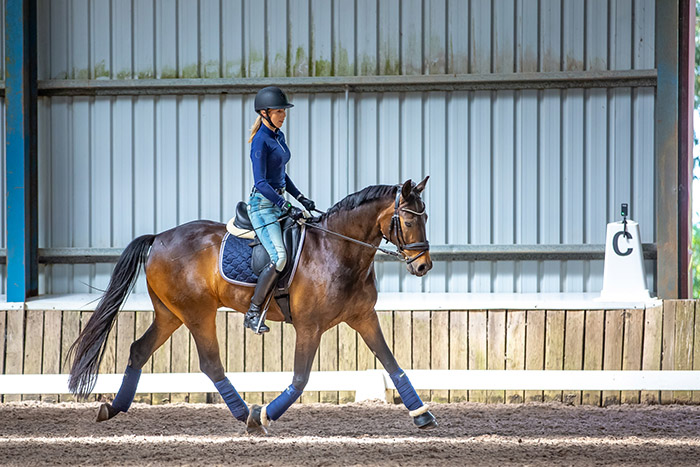 So instead we practise our canter-trot-canter transitions. “Don’t think so much about giving the canter aid. He needs to canter on the first application of the aid. The riders at the Spanish Riding School say the horse needs to ‘einspringen in den Zügel’ or jump into the rein,” Stefan says.
So instead we practise our canter-trot-canter transitions. “Don’t think so much about giving the canter aid. He needs to canter on the first application of the aid. The riders at the Spanish Riding School say the horse needs to ‘einspringen in den Zügel’ or jump into the rein,” Stefan says.
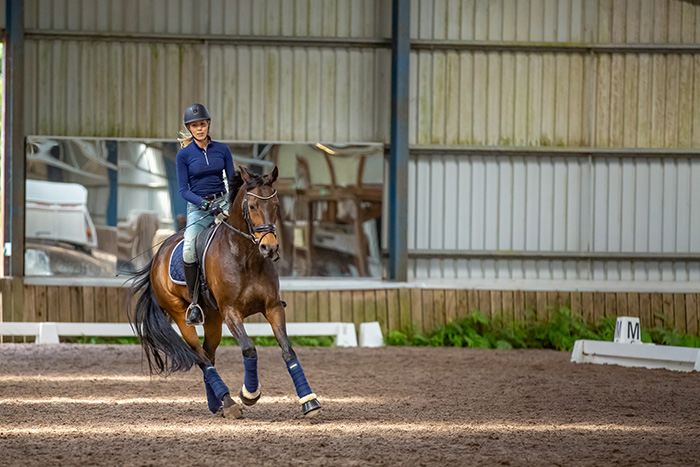
That is a good way to think of it and helps to ensure that the horse really jumps into the hand and works into the contact, instead of staying behind or going over the bit. The quality of the canter subsequently depends on the quality of the transition to canter. It is much easier to maintain a good canter, when the first stride is forward and balanced and takes me as the rider into an uphill, forward motion.
The same goes for the transition back into trot. Stefan comments that we need to carry on the forward movement instead of slamming on the brakes, “Don’t take your hand back, just continue to ride.”
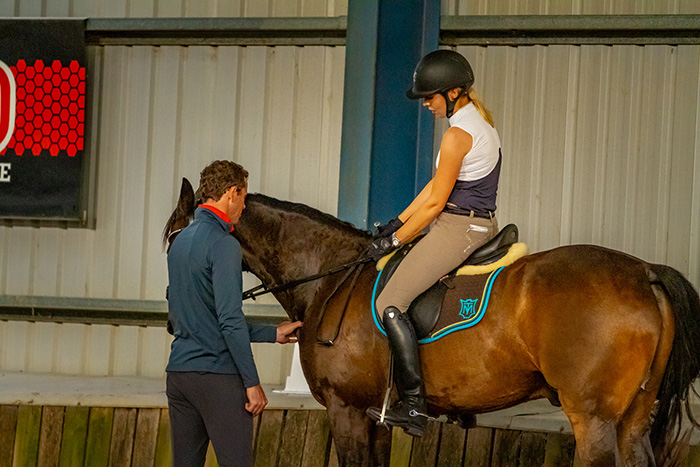
We stop to catch our breath and Stefan takes the opportunity to touch Dino on the chest. The reaction is immediate, Dino tries to bite him! We have the classic case of a very tight, dysfunctional Equine Brachiocephalicusmuscle, a common malady many performance horses experience. This muscle runs from the top of the horse’s poll to his point of shoulder and plays several important roles, it extends the shoulder, brings the limbs forward and flexes the neck towards the side of the protracting limb. Injury, strain or tightness in this area can be caused by several influences such as trauma, ill-fitting saddles, overuse, diminished oxygen or rider influence. Symptoms can range from restricted stride length to reduced shoulder extension and the ability to flex the neck on a circle.
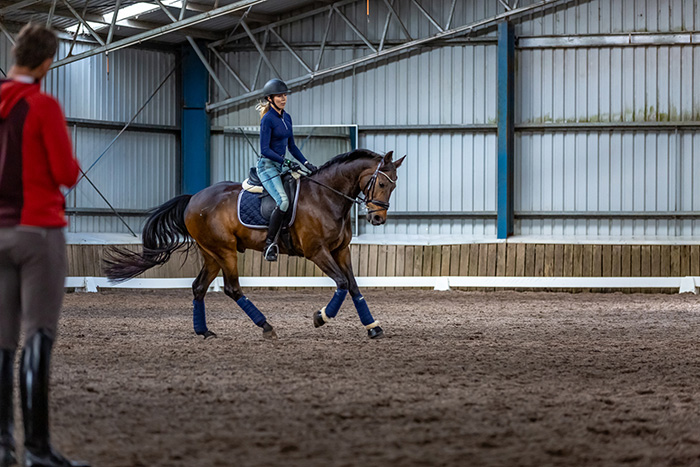
Thankfully this is a problem we can work on. Stefan asks me to ride Dino forward and downward, so that he relaxes past the point where the muscle hurts and realises it’s easier in this position. To do so I need to canter him long and low, but in a connected frame. Long and low does not equal flopping on the forehand, but riding the horse from back to front and into the hand. The canter is the most concerted exercise at lengthening all of the muscle groups and delivering more oxygen and blood to the tissue. That is why the trot always feels better after the canter.
Ridden with his neck longer and lower my horse starts to feel more like an accordion. His neck has now become an extension of the back, he is relaxed in the back muscles and I can feel the impulsion of his hindquarters flowing over his back and through his neck into a closed, softer mouth.
I leave the arena with more confidence knowing what I need to work on. My riding needs to improve my horse’s conformation by making him stronger and properly muscled so that he can move comfortably in self-carriage.
Day 3 – Baby Steps
Day 3 continues with more canter work and transitions on a 20-metre circle. “Don’t be so shy,” Stefan encourages. “I’d rather have him put in a little buck than continuing in a half-hearted way. Now that you put a little bit more pressure on, you notice that he is happier to drop into the contact. If you can secure this feeling as a rider, then you will be able to give the hand and let him stretch a little bit longer and lower for a few strides to ease the pressure, but while keeping the back active. Then collect him again for a few strides, then back to giving the reins. Repeat these transitions to prevent him from becoming stiff.”
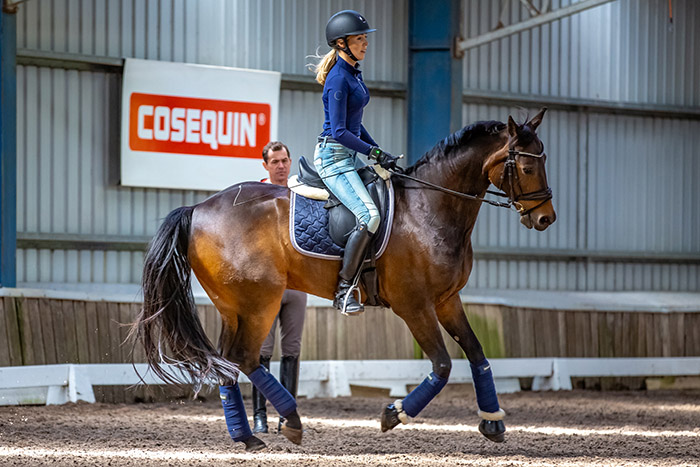
Success. Dino is accepting the bit and feels happier and more content in the contact from the beginning. It’s not perfect yet, but he starts to trust my hand, the contact is becoming lighter, but with a nice, comfortable weight that shows me he’s willing to work with me and not against me. My horse is honestly ‘on the rein’ and we can finally start incorporating some exercises such as counter canter and 10-metre canter circles into our work.
Stefan advises to ride the counter canter as if you hadn’t changed reins. “Close your eyes and pretend that you are still on the left hand. Be soft with your hand, don’t fight him. The horse will feel every rein aid twice as strong in his mouth. Find his tongue with your hand and elbow, so that he has a bit of guidance there. Then direct your driving aids there. Every step has to reach the hand.”
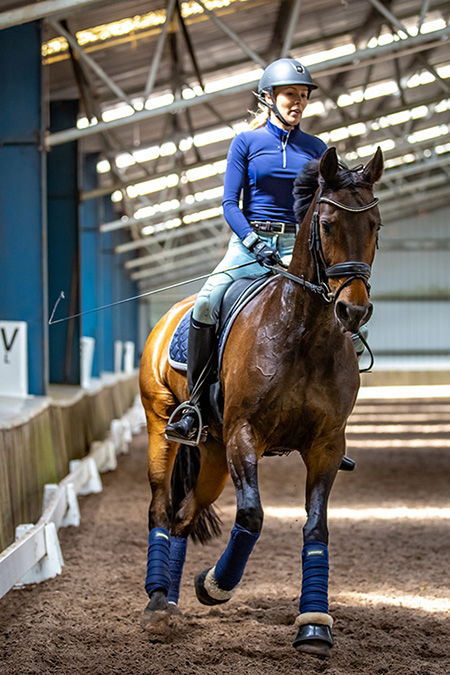
I am allowed to take my hand back a fraction, but not to block the horse, just to show him where he needs to go.
“Now you can move your finger a bit, so that he drops a little more in the neck and becomes even softer in the mouth. He’s a still a little bit cautious, his muscles need to swing a little more. Allow him to stretch now, allow him to drop his neck and influence your hand. Until now you have tried to influence his position, now it’s the reverse. A good contact also influences the rider. When the contact feels solid, allow him to take your hand. But it’s one or two centimetres, not more. His mouth needs to lead your hand.”
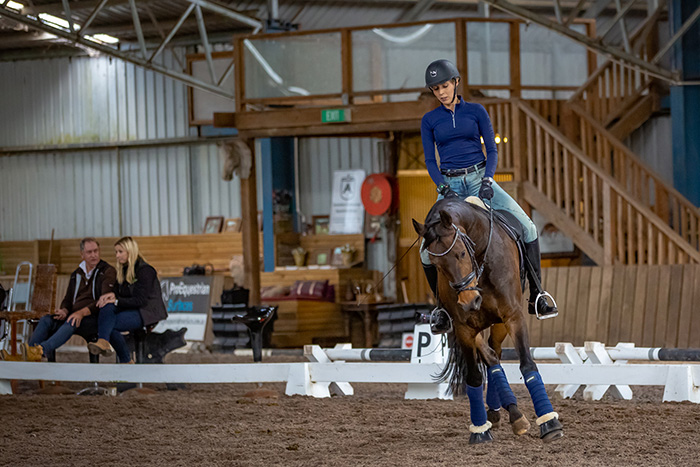
This is the outcome we need to work on and maintain in the future. Stefan provides further encouragement when he says that with a couple of weeks of consistent riding over the back our contact and suppleness issues will soon be solved and we can continue to advance in our training. One simply cannot force anything, any improvement must be solidified first, before we can take the next step.

Good riding is a never-ending lesson and on-going development, where patience is key and consistency the trusty keyring. In an ideal world I would have loved to have a fourth and fifth day, or better eight weeks (!) to build on what we achieved over the last three days, but for now it’s back to basics and some extra homework. Thank you Stefan, hope to see you again in Victoria soon!
